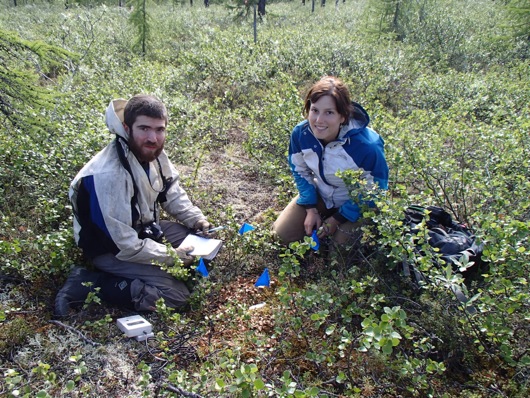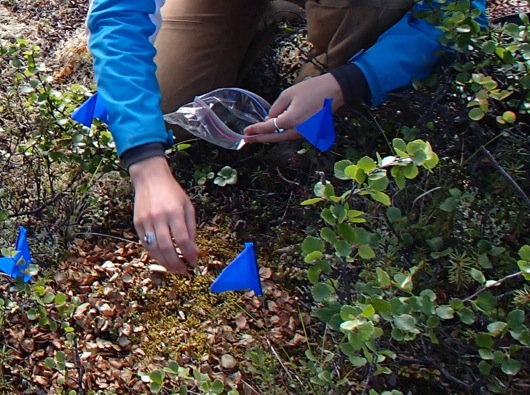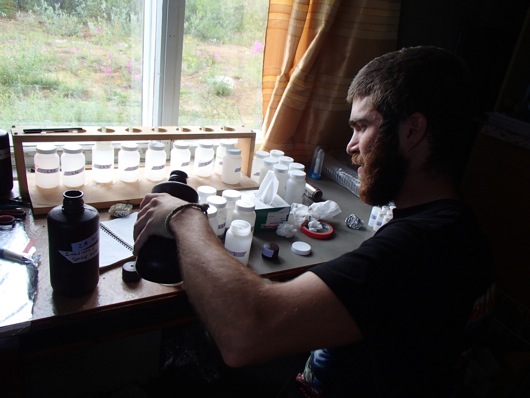(Mark Paricio is a PolarTREC Teacher accompanying the Polaris Project this summer. To read all of Mark’s journals, go to: http://www.polartrec.com/expeditions/siberian-arctic-systems-study )
Student Research – Brandi Jo Petronio and Peter Ganzlin (University of Florida)
Today, I accompanied Brandi Jo Petronio and Peter Ganzlin to the forests just beyond the experimental burn plots, where they are jointly conducting their research project. Their research centers on determining the effects of leaf litter on the growth of moss.

Peter Ganzlin and Bradi Jo Petronio at one of their 20 moss plots outlined by the four blue flags.
Why moss? Moss is Boss!
Peter and Brandi Jo tell me that in order to understand the value of their research it is important to know that the excellent insulating properties of the thick moss layers have a large impact on how deeply the permafrost soils thaw in the summer months, and consequently, how much stored carbon may be released into the environment. This question gains even more importance considering that, as the earth’s atmosphere has warmed and continues to warm, wildfires are becoming both more frequent and more severe. As forests regenerate after fires, the types and density of shrubs and trees that grow will affect the type and density of the leaf litter covering patches of moss. To know how moss growth is affected by the leaf litter produced after fires will help scientist better understand the effects of fire on the permafrost. The ability of moss patches to protect the permafrost layers below is why “Moss is Boss”.
Experimental Design
As they explained their plots to me, I was very impressed with Peter and Brandi Jo’s experimental design. Since the larch trees and dwarf birch shrubs dominate the forests near the science station, they have selected 20 moss plots to test the effects of the leaf litter (needle litter may be an appropriate descriptor for larch trees) dropped by these species. Four plots are being tested for the effects of high leaf litter from larch trees placed on the moss by the experimenters; four plots are being tested for the effects of low leaf litter from larch trees.

The green needles of larch trees turn brownish-orange and fall to the ground.

Peter takes a close-up photograph to document the effect of heavy larch litter on a moss plot.
Similarly, four moss plots are used for high levels of birch leaf litter and four more for low birch leaf litter levels.

Brandi Jo takes a moss sample from a plot covered with dwarf birch leaf litter. The green shrub on the right side of the picture is dwarf birch.
The final four moss plots are left uncovered as control plots. As I have walked around the forest near here, I have seen moss areas that resemble the plots they have constructed. They have also been careful to cut back the vegetation equally around each of the 20 moss plots so as to keep the effects of sunlight constant throughout their experiment. On each plot, they measure soil moisture, electrical conductivity, thaw depth, length of the green moss, and the chlorophyll content of the moss both before the experiment started and at intervals throughout the experiment. This means taking numerous field measurements and doing laboratory analyses on their moss samples, keeping them very busy!

Peter working in the lab to help another student’s experiment.

Brandi Jo prepares a moss sample for chlorophyll content analysis.
A Uniquely Strong Team
I had the privilege of spending time walking around the city of Yakutsk with them on our trip to the science station and found both Peter and Brandi Jo to be fascinating people to spend time with. They are each well traveled, down to earth, and light-hearted to be around. They have worked together previously in Alaska and at the University of Florida as research assistants and their teamwork in the field is seamless. Peter, who has degree in Soil Science from the University of Wisconsin, is looking toward pursuing a graduate degree in Forest Ecology. Brandi Jo will finish her bachelors degree this December in Wildlife Ecology and Conservation at the University of Florida.
I look forward to finding out the results of their study.
Stay curious my friends! – Mark Paricio



